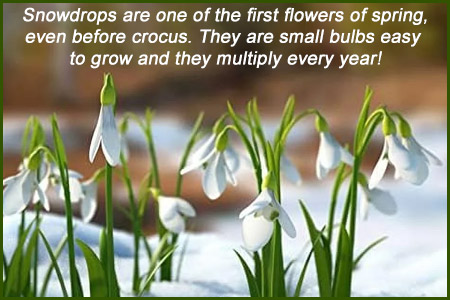New England Gardening Advice By the Month -February
Last Updated:
Winters have been milder in New England for the last 10 years or so. Normally, we'd be buried under at least a foot of snow and ice. These days here in coastal New England, I'm already looking at early signs of spring, with crocuses and snowdrops starting to peek out an inch or two from the top of the soil. Even some daffodils are braving the February chill and starting to pop out.

If this is true in your neck of the woods, it may be time to clear a little brush and leaves from your garden to make room for the new arrivals. Taking a rake through the garden to remove the heavy debris now will prevent you from having to do it later, when all these spring bulbs have really started to grow. Mostly it prevents you from damaging their tender leaves and stems from the harsh rake, and allows them to grow undisturbed. Just pick a relatively warm and dry day to get it done, and you'll be happy you did in a few weeks when it's much more difficult to do so.
For the plants that have survived the bulk of the winter indoors, it's time to think about pruning them back in anticipation of spring growth in a few weeks. With the longer days approaching, the sun is getting stronger on your plants, stimulating a growth spurt that will likely last for a few months. Pruning leggy or overgrown areas lets the plant concentrate on the remainder of the plant, resulting in fuller and stronger growth everywhere.
We usually don't recommend fertilizing the plants until this growth spurt is in full swing. The reason: you may encourage leggy winter growth that may have to be removed later. Better to wait a little bit and let the sun get even stronger before you encourage new growth.
Lastly, if you're wondering what to do with the spent amaryllis bulbs and poinsettias around the house, now is the time to do a little surgery on them with the hopes they'll bloom again next winter. For amaryllis, if the leaves are green, leave them alone and once outside temps are above 45 degrees at night, just place them outside in partial shade. They'll continue to grow all summer until August, when you'll cut off all the leaves at the top of the bulb and stop watering for 2 months. Then put the pot in a cool dry place until November when you'll bring it out in next to a sunny window, give it a good drink of water, and wait about 4 weeks for the bulb to rebloom.

For poinsettias, they probably look a little sickly after 2 months in the dry New England winter in our homes. It's perfectly ok to trim them down to about 6 inches above the soil, then when the time comes to put them outside, do so in partial shade with plenty of water and fertilizer. You'll be surprised how quickly they start to grow. Keep them well-watered and fertilized throughout the summer. When you bring them in during the fall, find a room that stays completely dark at night. These plants need at least 12 hours of complete darkness to do their magic. If you follow these guidelines, in early December you'll see the leaves start turning the familiar bright red and a set of small yellow flowers in the center. Repeat this process every year and you'll never have to buy another poinsettia again!